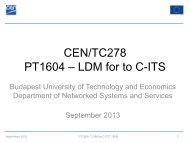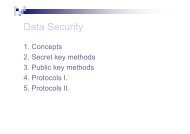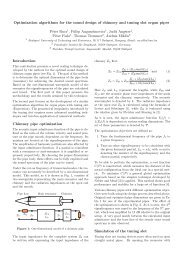Non-repudiation protocols
Non-repudiation protocols
Non-repudiation protocols
Create successful ePaper yourself
Turn your PDF publications into a flip-book with our unique Google optimized e-Paper software.
<strong>Non</strong>-<strong>repudiation</strong> <strong>protocols</strong><br />
Levente Buttyán<br />
Laboratory of Cryptography<br />
and System Security (CrySyS)<br />
Budapest University of<br />
Technology and Economics<br />
buttyan@crysys.hu<br />
© 2008 Levente Buttyán<br />
Outline and objective<br />
• outline<br />
– introduction, definitions<br />
– classification of non-<strong>repudiation</strong> <strong>protocols</strong><br />
– example <strong>protocols</strong><br />
• the objective is to understand<br />
– what does non-<strong>repudiation</strong> mean ?<br />
– what type of non-<strong>repudiation</strong> <strong>protocols</strong> do exist ?<br />
– what are the pros and cons of the various approaches ?<br />
• useful reading:<br />
– S. Kremer, O. Markowitch, J. Zhou, An Intensive Survey of Fair <strong>Non</strong><strong>repudiation</strong><br />
<strong>protocols</strong>, submission, April 2002.<br />
– literature on “fair exchange”<br />
<strong>Non</strong>-<strong>repudiation</strong> <strong>protocols</strong><br />
2/21
Introduction<br />
• in many applications, it is essential to ensure that<br />
participants of a transaction cannot deny having participated<br />
in the transaction<br />
• the problem can be traced back to the problem of non<strong>repudiation</strong><br />
of message origin and message delivery<br />
– non-<strong>repudiation</strong> of message origin<br />
• sender of the message cannot deny that he sent the message<br />
– non-<strong>repudiation</strong> of message delivery (receipt)<br />
• receiver of a message cannot deny that he received the message<br />
• ingredients of solutions<br />
– digital signatures, …<br />
– <strong>protocols</strong> that ensure fairness<br />
• proof of message origin is provided to the receiver only if a proof of<br />
message delivery is available to the sender, and vice versa<br />
<strong>Non</strong>-<strong>repudiation</strong> <strong>protocols</strong><br />
3/21<br />
Fairness<br />
• assume that A wants to send a message m to B<br />
• (strong) fairness:<br />
at the end of the protocol, either<br />
• B gets m and a non-<strong>repudiation</strong> of origin evidence for m, and<br />
• A gets a non-<strong>repudiation</strong> of delivery evidence for m<br />
or none of them get anything useful<br />
• an alternative, more precise definition:<br />
if both parties are rational, then at the end of the protocol, the<br />
following conditions hold<br />
• if A is honest, then B does not receive anything useful, unless A receives<br />
a non-<strong>repudiation</strong> of delivery evidence for m<br />
• if B is honest, then A does not receive anything useful, unless B receives<br />
m and a non-<strong>repudiation</strong> of origin for m<br />
<strong>Non</strong>-<strong>repudiation</strong> <strong>protocols</strong><br />
4/21
More definitions<br />
• weak fairness:<br />
if an honest party does not receive its evidence, while the other party does,<br />
then the first party receives a proof of this fact<br />
• probabilistic fairness:<br />
a protocol provides ε-fairness, if it guarantees fairness with probability ε<br />
• timeliness:<br />
– all honest parties can reach, in a finite amount of time, a point in the protocol<br />
where they can stop the protocol while preserving fairness<br />
• communication models:<br />
– unreliable channel: messages can be lost<br />
– resilient channel: all message are eventually delivered (after a finite, but<br />
unknown amount of time)<br />
– reliable (operational) channel: all messages are delivered within a known,<br />
constant amount of time (there’s an upper bound on the message delivery<br />
delay)<br />
<strong>Non</strong>-<strong>repudiation</strong> <strong>protocols</strong><br />
5/21<br />
Types of non-<strong>repudiation</strong> <strong>protocols</strong><br />
• no TTP (Trusted Third Party)<br />
• with TTP<br />
– on-line TTP<br />
• the TTP is involved in each run of the protocol<br />
– off-line TTP<br />
• the TTP is involved only if something goes wrong (a message is not<br />
received due to a communication error or some misbehavior)<br />
• we may assume that, most of the time, there won’t be any problems, so<br />
the protocol can be optimized (in terms of efficiency) for the faultless<br />
case ( also called optimistic <strong>protocols</strong>)<br />
<strong>Non</strong>-<strong>repudiation</strong> <strong>protocols</strong><br />
6/21
A protocol with an on-line TTP<br />
• protocol:<br />
1. A TTP : E TTP<br />
( A, B, m, sig A<br />
(A, B, h(m)) )<br />
2. TTP B : A, B, h(m), sig TTP<br />
(A, B, h(m))<br />
3. B TTP : E TTP<br />
( sig B<br />
(A, B, h(m)) )<br />
4a. TTP A : sig B<br />
(A, B, h(m))<br />
4b. TTP B : m, sig A<br />
(A, B, h(m))<br />
• notes:<br />
– NRO = sig A<br />
(A, B, h(m)), NRR = sig B<br />
(A, B, h(m))<br />
– E TTP<br />
( ) is used to prevent eavesdropping of m and the evidences<br />
– TTP is trusted for checking signatures and sending messages 4a and 4b<br />
simultaneously<br />
– fairness is based on this simultaneous transmission of 4a and 4b, but there<br />
are problems:<br />
• if channels are resilient, then it is unclear how long the TTP should wait for B’s<br />
response, and thus, how long A should wait for the TTP’s message (timeliness is<br />
not guaranteed)<br />
• the TTP may crash between sending 4a and sending 4b, and leave B in an unfair<br />
situation<br />
<strong>Non</strong>-<strong>repudiation</strong> <strong>protocols</strong><br />
7/21<br />
Fixing the timeliness problem<br />
• protocol:<br />
1. A TTP : E TTP<br />
( A, B, m, T, NRO = sig A<br />
(A, B, h(m), T) )<br />
2. TTP B : A, B, h(m), T, sig TTP<br />
(A, B, h(m), T)<br />
3. B TTP : E TTP<br />
( NRR = sig B<br />
(A, B, h(m), T) )<br />
if TTP receives msg 3 before T:<br />
4. TTP publishes at T: A, B, h(m), T, m, NRO, NRR<br />
else:<br />
4’. TTP publishes at T: A, B, h(m), T, “ABORTED”<br />
5a. after T, A checks for the result of the protocol<br />
5b. after T, B checks for the result of the protocol<br />
• notes:<br />
– the TTP can publish results by making them available through a server (e.g.,<br />
through the web)<br />
– if TTP crashes before step 4, then no result will be available (for some time),<br />
but fairness is still preserved<br />
– in any case, A and B should continue polling the server until they receive<br />
some response (their evidences or the abort indication)<br />
– if channels are resilient, the protocol will end after a finite amount of time<br />
<strong>Non</strong>-<strong>repudiation</strong> <strong>protocols</strong><br />
8/21
Another variant (Zhou-Gollmann)<br />
• protocol:<br />
C = E K<br />
(m) where K is a random session key<br />
1. A B : A, C, T, NRO1 = sig A<br />
(A, B, C, T)<br />
2. B A : B, NRR1 = sig B<br />
(A, B, C, T)<br />
3. A TTP : E TTP<br />
( A, B, T, K, sig A<br />
(A, B, T, K) )<br />
4. TTP publishes at T: A, B, T, K, NROR2 = sig TTP<br />
(A, B, T, K)<br />
5a. after T, A tries to download NROR2<br />
5b. after T, B tries to download NROR2<br />
NRO = NRO1 + NROR2<br />
NRR = NRR1 + NROR2<br />
• notes:<br />
– NROR2 means<br />
• as part of NRO: K was sent by A before T<br />
• as part of NRR: K was made available to B after T<br />
– if, in step 5, NROR2 is not on the server, then the downloading party can<br />
stop the protocol (in order to preserve fairness, the TTP should not ever<br />
publish NROR2 after T)<br />
<strong>Non</strong>-<strong>repudiation</strong> <strong>protocols</strong><br />
9/21<br />
A protocol with an off-line TTP<br />
• main protocol:<br />
1. A B : A, B, id, E K (m), E TTP (K), NRO1 = sig A ( … )<br />
2. B A : A, B, id, NRR = sig B ( A, B, id, E K (m), E TTP (K) )<br />
3. A B : A, B, id, K, NRO2 = sig A ( … )<br />
if B timeouts, then call the recovery protocol<br />
NRO = NRO1 + NRO2<br />
• recovery protocol (only for B):<br />
1. B TTP : A, B, id, E K (m), E TTP (K), NRO1, NRR<br />
2. TTP B : A, B, id, K, NRO2’ = sig TTP ( … )<br />
3. TTP A : A, B, id, NRR<br />
NRO’ = NRO1 + NRO2’<br />
• notes:<br />
– if A does not send message 3, then B can invoke the recovery protocol to re-establish<br />
fairness<br />
– B will then get NRO’ != NRO<br />
– B may start recovery without sending message 2 (and hence NRR)<br />
– that is why B must also provide NRR during recovery, which is then sent to A<br />
– what if A sends E TTP (K’) in message 1?<br />
<strong>Non</strong>-<strong>repudiation</strong> <strong>protocols</strong><br />
10/21
A timeliness problem again<br />
• A does not know when to stop if message 2 doesn’t arrive<br />
– if she stops, B may start the recovery protocol and obtain NRO’ (while<br />
A will no longer receive NRR)<br />
– so she should wait, but B may have indeed stopped the protocol, and<br />
A will wait forever<br />
• a potential solution<br />
– an abort protocol that A can call any time to force termination<br />
<strong>Non</strong>-<strong>repudiation</strong> <strong>protocols</strong><br />
11/21<br />
A protocol with an off-line TTP – revised<br />
• main protocol:<br />
1. A B : A, B, id, E K (m), E TTP (K), NRO1 = sig A ( A, B, id, E K (m), E TTP (K) )<br />
2. B A : A, B, id, NRR1 = sig B ( A, B, id, E K (m), E TTP (K) )<br />
if A timeouts, then call the abort protocol<br />
3. A B : A, B, id, K, NRO2 = sig A ( A, B, id, K )<br />
if B timeouts, then call the recovery protocol<br />
4. B A : A, B, id, NRR2 = sig B ( A, B, id, K )<br />
if A timeouts, then call the recovery protocol<br />
NRO = NRO1 + NRO2; NRR = NRR1 + NRR2<br />
• abort protocol (only for A):<br />
1. A TTP : A, B, id, “PLEASE ABORT”<br />
if already aborted or recovered then stop, else aborted = TRUE and …<br />
2. TTP A : A, B, id, “ABORTED”, sig TTP ( … )<br />
3. TTP B : A, B, id, “ABORTED”, sig TTP ( … )<br />
• recovery protocol (for X in {A, B}):<br />
1. X TTP : A, B, id, E K (m), E TTP (K), NRO1, NRR1<br />
if already aborted or recovered then stop, else recovered = TRUE and …<br />
2. TTP A : A, B, id, K, NRR2’ = sig TTP ( … ), NRR1<br />
3. TTP B : A, B, id, K, NRO2’ = sig TTP ( … )<br />
<strong>Non</strong>-<strong>repudiation</strong> <strong>protocols</strong><br />
12/21
Properties<br />
• fairness:<br />
– if B feels something is going wrong, then he can invoke the recovery protocol<br />
at any time after receiving message 1 (which is the starting point for B)<br />
– if A feels something is going wrong, then she can invoke the recovery<br />
protocol after receiving message 2<br />
– before that, she can cancel the transaction by calling the abort protocol<br />
– abort and recovery are mutually exclusive<br />
– when A invoked the abort protocol, she shouldn’t continue the main protocol<br />
(even if B’s message arrives later)<br />
• B may misbehave (e.g., doesn’t send message 4), and A cannot call the recovery<br />
protocol anymore<br />
• an abort evidence is not a proof that the transaction didn’t take place, because the<br />
abort protocol can be called after a successful run of the protocol<br />
• timeliness<br />
– at each point in the protocol both parties can force termination either by<br />
calling the recovery protocol or the abort protocol<br />
• TTP is not transparent<br />
– evidences produced in the protocol when TTP is used are different from<br />
those that are produced in the case when no TTP is used<br />
<strong>Non</strong>-<strong>repudiation</strong> <strong>protocols</strong><br />
13/21<br />
Protocols with no TTP<br />
• strong fairness cannot be achieved without a TTP<br />
– assume that P is a protocol that<br />
• does not use a TTP<br />
• achieves strong fairness<br />
• and uses minimum number n of messages<br />
– assume w.l.o.g. that the last message of P is sent by A to B<br />
– before sending this last message A has its evidences, because she<br />
does not receive anything else in the protocol<br />
– on the other hand, before receiving this last message, B still needs<br />
something, otherwise the last message would be useless, and we<br />
could have a fair non-<strong>repudiation</strong> protocol P’ with n-1 messages<br />
– therefore, if A does not send the last message, then B will suffer a<br />
disadvantage, and hence, P cannot be fair<br />
• <strong>protocols</strong> with no TTP try to achieve weaker forms of<br />
fairness (e.g., probabilistic fairness)<br />
<strong>Non</strong>-<strong>repudiation</strong> <strong>protocols</strong><br />
14/21
A protocol with no TTP providing probabilistic fairness<br />
• protocol:<br />
C = E K<br />
(m) where K is a random key<br />
1. A B : A, B, id, C, NRO 0<br />
= sig A<br />
( A, B, id, C )<br />
2. B A : A, B, id, NRR 0<br />
= sig B<br />
(A, B, id, C)<br />
with prob. ε, r 1<br />
= K, and with prob. 1-ε, r 1<br />
is a random number<br />
3. A B : A, B, id, 1, r 1<br />
, NRO 1<br />
= sig A<br />
( A, B, id, 1, r 1<br />
)<br />
4. B A : A, B, id, NRR 1<br />
= sig B<br />
( A, B, id, 1, r 1<br />
)<br />
…<br />
with prob. ε, r n<br />
= K, and with prob. 1-ε, r n<br />
is a random number<br />
2n+1. A B : A, B, id, n, r n<br />
, NRO n<br />
= sig A<br />
( A, B, id, n, r n<br />
)<br />
2n+2. B A : A, B, id, NRR n<br />
= sig B<br />
( A, B, id, n, r n<br />
)<br />
– A stops when K is sent or if she does not receive a response from B within<br />
some timeout time<br />
– B stops when he does not receive the next message from A within some<br />
timout time<br />
– NRO = NRO 0<br />
+ NRO n<br />
; NRR = NRR 0<br />
+ NRR n<br />
• important assumption:<br />
– decryption of C takes longer time than the timeout set by A in each step if<br />
B tries to test r i<br />
, then A timeouts and stops the protocol<br />
<strong>Non</strong>-<strong>repudiation</strong> <strong>protocols</strong><br />
15/21<br />
Brief analysis<br />
• fairness for B:<br />
– if A has NRR n<br />
, then B must have NRO n<br />
(given that B is honest)<br />
• fairness for A:<br />
– in each step of the protocol, B may decide to stop<br />
– he gets in advantageous situation (B has NRO n<br />
, but A doesn’t have NRR n<br />
)<br />
with prob. ε<br />
– B’s decision is wrong with prob. 1-ε, and in this case, fairness is preserved<br />
• timeliness:<br />
– it is safe to stop for B at any time in the protocol<br />
– but how long should A wait for B’s last message?<br />
• if A stops prematurely, then she may end up in a disadvantageous state<br />
• A should wait for B’s response, but it may not have been sent by B<br />
• overhead problem<br />
– parameter ε should be small for better fairness<br />
– the smaller ε is, the larger n is good fairness results in high overhead<br />
<strong>Non</strong>-<strong>repudiation</strong> <strong>protocols</strong><br />
16/21
Another approach with no TTP – first attempt<br />
• A wants to send message m to B<br />
• NRO = sig A (A, B, h(m)), NRR = sig B (A, B, h(m))<br />
• protocol:<br />
– A generates a random key k A<br />
and encrypts m and NRO {m, NRO} kA<br />
– A sends h(m) and {m, NRO} kA<br />
to B<br />
– B generates a random key k B<br />
and encrypts NRR {NRR} kB<br />
– B sends {NRR} kB<br />
to A<br />
– A and B exchange k A<br />
and k B<br />
bit by bit:<br />
• in the i-th step A sends k A [i] and B sends K B [i]<br />
– at the end, both A and B decrypt the encrypted items and check them<br />
• problem: what if a party sends random bits instead of the real key?<br />
• each party must be able to verify that the other really sends the bits of<br />
his/her key !<br />
<strong>Non</strong>-<strong>repudiation</strong> <strong>protocols</strong><br />
17/21<br />
A useful building block: bit commitment<br />
• a bit commitment protocol ensures that A can commit to a binary value b<br />
in such a way that<br />
– B cannot learn the committed value until A opens the commitment<br />
– A cannot later change the committed value and claim that she has committed<br />
to b’ (instead of b)<br />
• an example based on a collision resistant, one-way hash function H:<br />
– A wants to commit to a bit b<br />
– A generates a random number r (of sufficient length)<br />
– A computes c = H(r | b)<br />
– A sends c to B<br />
• B cannot compute b, because H is one-way<br />
– when A wants to open the commitment, she sends (r, b) to B<br />
– B verifies that H(r | b) = c<br />
• in order to cheat, A should be able to find r’ such that H(r’ | b’) = H(r | b)<br />
• this is not possible, because H is collision resistant<br />
<strong>Non</strong>-<strong>repudiation</strong> <strong>protocols</strong><br />
18/21
Second attempt<br />
• A sends to B:<br />
[A, B, h(m), {m, NRO} k A , C A , Sig A (…)]<br />
where C A = ( H(p 1 | k A [1]), …, H(p L | k A [L]) ), L is the bit length of k A ,<br />
and p i are random numbers<br />
• B sends to A:<br />
[B, A, h(m), {NRR} k B , C B , Sig B (…)]<br />
where C B = ( H(q 1 | k B [1]), …, H(q L | k B [L]) ), and q i are random<br />
numbers<br />
• A and B open their commitments one after the other:<br />
– A sends (p i<br />
, k A<br />
[i]) and B sends (q i<br />
, k B<br />
[i])<br />
– A and B verify that they received the committed bits<br />
• at the end, both A and B decrypt the encrypted items and check them<br />
<strong>Non</strong>-<strong>repudiation</strong> <strong>protocols</strong><br />
19/21<br />
Brief analysis<br />
• let us assume that A is honest and B stops after the t-th step<br />
• A has<br />
[B, A, h(m), enc, C B<br />
, Sig B<br />
(…)]<br />
(q 1<br />
, k[1]), …, (q t<br />
, k[t])<br />
• if it is infeasible for A to determine the rest of k B (t is too small), then it is<br />
infeasible for B as well to determine the rest of k A<br />
• assume that t is large enough, and A tries to determine the rest of k B<br />
– she tries to decrypt enc with k[1..t] | k[t+1..L] for all possible values of<br />
k[t+1..L]<br />
– she may succeed<br />
• B needs almost the same amount of effort to succeed<br />
– if she doesn’t succeed then she has a proof that B has cheated<br />
• k[1..t] are the bits committed by B<br />
• there’s no k[t+1..L] such that decrypting enc with k[1..t] | k[t+1..L] results in NRR<br />
• B’s signature proves that B provided false information to A<br />
<strong>Non</strong>-<strong>repudiation</strong> <strong>protocols</strong><br />
20/21
Some conclusions<br />
• two important requirements for non-<strong>repudiation</strong> <strong>protocols</strong> are fairness<br />
and timeliness<br />
• there are many subtle details to consider during the design (formal<br />
methods?)<br />
• types:<br />
– with on-line TTP<br />
• <strong>protocols</strong> of this kind are conceptually simple, but<br />
• TTP is a bottleneck and a single point of failure<br />
– with off-line TTP<br />
• (full) protocol is complex, but main protocol can be simple<br />
• less demand on the TTP, efficient in case of no faults<br />
– with no TTP<br />
• true fairness cannot be achieved<br />
• lot of overhead<br />
• strong assumptions (e.g., equal computing capacity of the parties)<br />
• relation to fair exchange (of general items)<br />
– can be considered as subclass of fair exchange <strong>protocols</strong><br />
<strong>Non</strong>-<strong>repudiation</strong> <strong>protocols</strong><br />
21/21

















